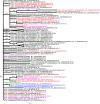Retrospective screening of routine respiratory samples revealed undetected community transmission and missed intervention opportunities for SARS-CoV-2 in the United Kingdom
- PMID: 34130773
- PMCID: PMC8459093
- DOI: 10.1099/jgv.0.001595
Retrospective screening of routine respiratory samples revealed undetected community transmission and missed intervention opportunities for SARS-CoV-2 in the United Kingdom
Abstract
In the early phases of the SARS coronavirus type 2 (SARS-CoV-2) pandemic, testing focused on individuals fitting a strict case definition involving a limited set of symptoms together with an identified epidemiological risk, such as contact with an infected individual or travel to a high-risk area. To assess whether this impaired our ability to detect and control early introductions of the virus into the UK, we PCR-tested archival specimens collected on admission to a large UK teaching hospital who retrospectively were identified as having a clinical presentation compatible with COVID-19. In addition, we screened available archival specimens submitted for respiratory virus diagnosis, and dating back to early January 2020, for the presence of SARS-CoV-2 RNA. Our data provides evidence for widespread community circulation of SARS-CoV-2 in early February 2020 and into March that was undetected at the time due to restrictive case definitions informing testing policy. Genome sequence data showed that many of these early cases were infected with a distinct lineage of the virus. Sequences obtained from the first officially recorded case in Nottinghamshire - a traveller returning from Daegu, South Korea - also clustered with these early UK sequences suggesting acquisition of the virus occurred in the UK and not Daegu. Analysis of a larger sample of sequences obtained in the Nottinghamshire area revealed multiple viral introductions, mainly in late February and through March. These data highlight the importance of timely and extensive community testing to prevent future widespread transmission of the virus.
Keywords: COVID-19; Community Transmission; Molecular Epidemiology; Pooled Screening; SARS-CoV-2; Whole-Genome Sequencing.
Conflict of interest statement
The authors declare that there are no conflicts of interest.
Figures




References
-
- World Health Organization Who coronavirus disease (COVID-19) Dashboard. Who.int. https://covid19.who.int/
Publication types
MeSH terms
Substances
Grants and funding
LinkOut - more resources
Full Text Sources
Medical
Miscellaneous

